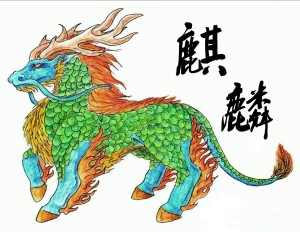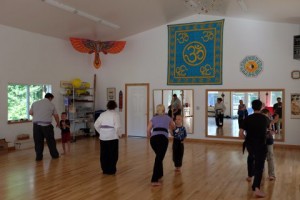Qilin Quan (Chi Lin Chuan) is a kung fu style based on animal movements and tactics. Qilin Quan incorporates internal and external styles of martial arts and is adaptive to the practitioner’s personality and body type. Many different Qilin Quan forms have been developed including empty-hand forms and weapons forms. The Qilin is a mythical Chinese creature that is able to assume the aspect of any animal, and so Qilin Quan practitioners train to emulate the Qilin by being adaptable. Other characteristics of the Qilin are being courageous, wise, loyal, honest and having personal integrity.

Our martial arts class utilizes the Chinese art of Qilin Quan Kung Fu to teach the basics of martial arts animal movements, focus, self-control, self-defense, strength, flexibility, grace, balance, self-awareness, mental health, and social awareness. The class promotes cooperation, not competition, and combines traditional and creative teaching methods. The teaching style is multi-sensory and combines development of self-discipline with steady-paced, fun-filled training.
One emphasis of this class is the development of the focus required to be a good learner, and often benefits student’s school and/or work behavior. Students in this class learn at their own pace, and the class is a mixture of students with different abilities who interact in positive ways.
This class is multi-generational and welcomes students ages five and up. It is especially appropriate for families because of the acceptance of diverse levels of learning and the intentional focus upon development of social interest. Students are encouraged to practice movements on their own at home, but not to show off by applying them to others, parents, children, siblings, or friends. Emphasis is placed on how to resolve conflict using mental self-defense and relying on physical skills as a last resort.
Students are challenged to perform a number of physical and mental tasks that may initially be beyond their ability, but these tasks are presented in an atmosphere of true learning where honest mistakes are cause for celebration, not reprimand, and where students can learn to encounter frustration in an effective manner, with persistence and patience. They are rewarded for encouraging one another, not for being better than one another.
The students are asked to work hard physically. They learn to recognize the difference between physical discomfort that indicates growth and harmful pain. There is a lot of fun too, but fun is built into a system of self-control, respect for one another, and an awareness of others. The entire class does push-ups or horse-dips as a direct result of one student’s loss of self-control or unwanted behavior. Beyond the obvious physical benefit, the reason for this is that this class is not run in a traditional autocratic manner. People usually discipline themselves better when the consequence of their actions causes everyone, including the teachers, to be immediately and negatively affected. This contributes to the social awareness that our actions as individuals do indeed impact the community around us.

Friends and family members who are not participants are invited to observe any or all of the classes. Visitors may participate once for free, but no visitor may correct or interfere with a student during the class unless requested by the teachers. It is requested that if little ones are with you they do not interfere with class.
As responsible martial arts instructors we recognize our duty, especially in these violent times, to emphasize the aspects of martial arts study which actually reduce violent conflict in this world. Conflict management skills are taught. Our martial arts class teaches that in order to conquer an opponent we must become as one with them; to understand the flaws in their technique. Students learn that the truly strong person is the one who can avoid the fight, that controlling ones fear or anger, keeping your head, and walking away if you can, is the way to truly win any battle. This class teaches students to deal with their mental dragon of stress, low self-esteem, anger, depression and anxiety.
At the beginning and the end of each class (and anytime the students leave or enter the practice area) they are required to bow. This practice is an external reminder that once the student enters into the practice of martial arts that they leave behind their more casual everyday selves and actions. They are entering the world of martial arts practice, with special demands upon personal behavior; which includes self-control, attention, respect for others and group cooperation. This also means that once the student has bowed in that they must relate to one another as fellow martial arts students, no longer as buddies, parents, sons, daughters, sisters or brothers to any of the other students, even if that was their relationship before and after class. So if a parent decides to join the class they must no longer relate to their child in a parental role, but leave the corrections to the teachers.
There is no expensive or formal uniform required for the class, but students must wear sneakers, and sweatpants or shorts, and a plain T-shirt. Many people ask about a ranking or belt system. The Qilin system has only three levels, but being a traditional family system, the level one achieves is recognized by their own personal skill level not by the color of their sash. Sashes are worn by the students, but do not denote rank. In this class we will emphasize skill achievement, not belt color, as goal setting markers. Before class the students may, after changing their clothing, quietly practice basic movements (individually), do calisthenics, or stretch. They are NOT permitted to be rowdy or fight; or practice with any weapons without express permission of an instructor.

At the end of each class we practice a basic breathing meditation by chanting. This teaches how to attain inner calmness through control of the muscles involved in proper breathing. Through this the students will be taught control of superficial pain, and control of such emotions as anger and anxiety. Also at this time there are often discussions and stories which promote positive values.